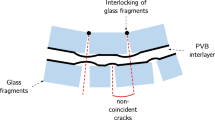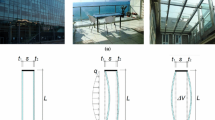Abstract
Pre-tensioned high strength trusses using alloy steel bar are widely used as glass wall supporting systems because of the high degree of transparency. The breakage of glass panes in this type of system occurs occasionally, likely to be due to error in design and analysis in addition to other factors like glass impurity and stress concentration around opening in a spider system. Most design does not consider the flexibility of supports from finite stiffness of supporting steel or reinforced concrete beams. The resistance of lateral wind pressure of the system makes use of high tension force coupled with the large deflection effect, both of which are affected by many parameters not generally considered in conventional structures. In the design, one must therefore give a careful consideration on various effects, such as support settlement due to live loads and material creep, temperature change, pre-tension force, and wind pressure. It is not uncommon to see many similar glass wall systems fail in the wind load test chambers under a design wind speed. This paper presents a rigorous analysis and design of this type of structural systems used in a project in Hong Kong, China. The stability function with initial curvature is used in place of the cubic function, which is only accurate for linear analysis. The considerations and analysis techniques are believed to be of value to engineers involved in the design of the structural systems behaving nonlinearly.
Similar content being viewed by others
References
The Institution of Structural Engineers. Structural Uses of Glass in Buildings. London: The Institution of Structural Engineers, 1999
Coles R N. Managing the interface between building structures and glass tension structures. In: Ledbetter S, Harris R, eds. Proceedings of International Conference on “Use of Glass as an Architectural/Engineering Form and Material”. Sydney, 1999, 111–117
Mocibob D, Belis J. Coupled experimental and numerical investigation of structural glass panels with small slenderness subjected to locally introduced axial compression. Engineering Structures, 2010, 32(3): 753–761
Zhou Z H, Chan S L. Elastoplastic and large deflection analysis of steel frames by one element per member. Part 1: One hinge along member. Journal of Structural Engineering, 2004, 130(4): 538–544
Chan S L, Zhou Z H. Elastoplastic and large deflection analysis of steel frames by one element per member. Part 2: Three hinges along member. Journal of Structural Engineering, 2004, 130(4): 545–553
NIDA. Structural Analysis Software for Nonlinear Integrated Design and Analysis, User’s Manual. Hong Kong: The Hong Kong Polytechnic University, 2009
Author information
Authors and Affiliations
Rights and permissions
About this article
Cite this article
Chan, SL., Liu, Y. & Lee, A. Nonlinear analysis of pre-tensioned glass wall facade by stability function with initial imperfection. Front. Archit. Civ. Eng. China 4, 376–382 (2010). https://doi.org/10.1007/s11709-010-0086-2
Received:
Accepted:
Published:
Issue Date:
DOI: https://doi.org/10.1007/s11709-010-0086-2




